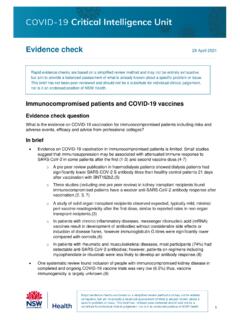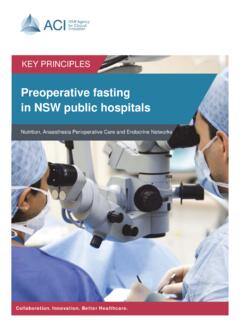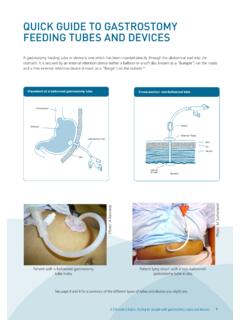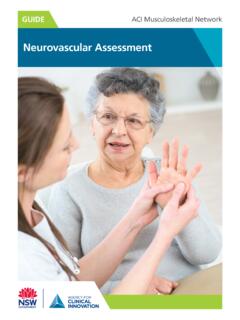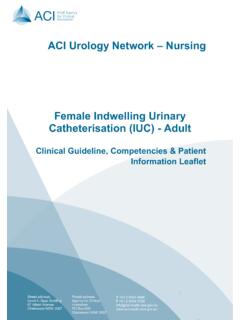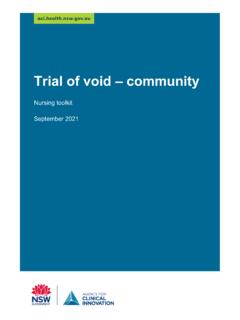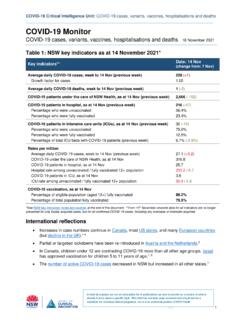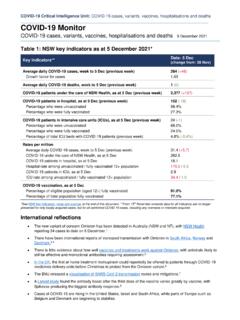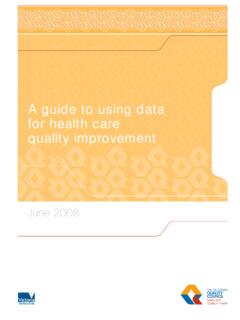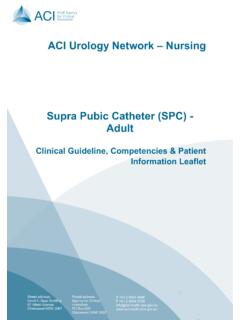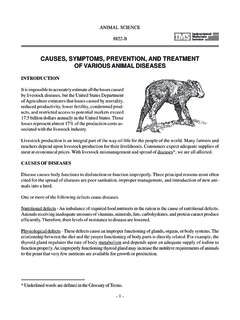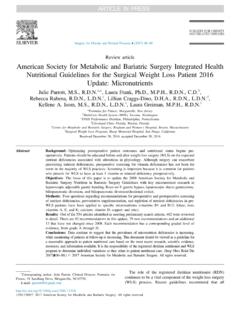Transcription of Evidence based practice guidelines for the Dietetic ...
1 1 Endorsed by Dietitians New Zealand. These guidelines have been independently reviewed by the Dietitians Association of Australia (DAA) and as a result are endorsed by the DAA. Evidence based practice guidelines for the Dietetic management of adults with pressure injuries Trans Tasman Dietetic Wound Care Group Review 1: 2011 2 Contents EXECUTIVE SUMMARY .. 3 SUMMARY OF Evidence based RECOMMENDTATIONS .. 4 Pressure injury nutrition treatment quick reference 6 INTRODUCTION .. 8 Background to Review 1: 2011 .. 8 Clinical background .. 9 Purpose and scope .. 11 Methods .. 11 Review process .. 14 14 Evidence based STATEMENTS .. 16 Nutrition screening .. 16 Dietetic assessment .. 17 Obese patient Spinal cord injured patient Nutrition goals, interventions and monitoring .. 23 Cultural, legal and ethical considerations.
2 32 REFERENCES .. 35 Appendix 1: Author details .. 40 Appendix 2: 2011 Expert Review Panel .. 42 Appendix 3: NHMRC Additional levels of Evidence and grades of recommendations .. 43 Appendix 4: Evidence summary of Arginine Supplement Trials .. 44 Implementation Toolkit .. 46 Example standard of care .. 49 Pressure injury Dietetic quick reference 3 EXECUTIVE SUMMARY A pressure injury is a localised injury to the skin and/or underlying tissue usually over a bony prominence, as a result of pressure, or pressure in combination with shear. A number of contributing or confounding factors are also associated with pressure injuries; the significance of these factors is yet to be elucidated. 1 Severity of pressure injuries can range from small red areas to deep, full tissue thickness wounds. Malnutrition is an independent risk factor for pressure injury development.
3 Due to the role of nutrition in many aspects of the healing process nutritional status has a major impact on the treatment of pressure injuries. Nutrition is implicated in the immune response set up by the body to reduce infection as well as the provision of nutrients to build new tissue and optimise circulation to the wound site. Presence of other conditions may affect nutrient requirements for example infection, malabsorption, and chronic diseases such as diabetes or obesity. The nutrient requirements to heal a small stage 1 pressure injury vary considerably to the requirements of those needed to heal a necrotic stage 4 (severe) pressure injury, as would non-exudating versus highly exudating wounds. These issues, as well as the varying nutrient requirements at different stages of the wound healing process make nutritional review and monitoring essential.
4 This is the first review of Dietitians New Zealand (Dietitians NZ) Evidence based practice guidelines for the Dietetic management of adults with pressure injuries. The original guidelines , endorsed by Dietitians NZ in 2008, contained a review of research available until June 2006. This review document includes a review of available research published until January 2010. The recommendations made are designed to guide practice and assist in the decision making process that is undertaken when assessing and treating patients. A Trans-Tasman approach was taken for the review of these guidelines to facilitate use by New Zealand Registered Dietitians as well as Australian Accredited Practicing Dietitians. The purpose of this document is to provide New Zealand Registered Dietitians and Australian Accredited Practising Dietitians with an Evidence - based practice guideline to maximise the effectiveness of nutritional interventions in the healing of pressure injuries in adult patients.
5 This document is to be used as a guideline only and does not replace individual patient assessment by a dietitian. These guidelines are based on a rigorous process to develop Evidence based practice and practice based Evidence guidelines . 4 SUMMARY OF Evidence based RECOMMENDTATIONS The guideline recommendations have been graded using the National Health and Medical Research Council (NHMRC) 2 classification for grades of recommendations, which are as follows: Level A Body of Evidence can be trusted to guide practice . Level B Body of Evidence can be trusted to guide practice in most situations. Level C Body of Evidence provides some support for recommendation(s) but care should be taken in its application. Level D Body of Evidence is weak and recommendation(s) must be applied with caution. 1. Nutrition screening Clinical question 1.
6 What nutrition screening process can be used to best identify adults at risk of poor healing of pressure injuries due to nutritional problems? Evidence - based recommendation Nutrition screening, using a validated tool for the appropriate clinical setting, should be undertaken on all adults with pressure injuries to identify those at risk of poor healing due to nutritional problems. NHMRC Grade of Recommendation: B 2. Nutrition assessment Clinical question 2a. How should the nutritional status of adults with pressure injuries be assessed? Evidence - based recommendation The nutritional status of patients with pressure injuries should be assessed using weight, food intake measures, BMI, anthropometry and biochemistry to identify nutritional issues that may impact upon healing potential. NHMRC Grade of Recommendation: C As malnutrition impacts on healing potential, a validated nutrition assessment tool appropriate to the population in which it is to be applied should be used.
7 NHMRC Grade of Recommendation: B Clinical question 2b. How should the nutritional requirements of obese patients with pressure injuries be determined? practice recommendation nutritional requirements of obese patients with pressure injuries should be calculated with caution, using weight, food intake measures, BMI, anthropometry and biochemistry. NHMRC Grade of Recommendation: D Clinical question 2c. How should the nutritional requirements of patients with spinal cord injuries (SCI) and pressure injuries be determined? Evidence - based recommendation nutritional requirements of SCI patients with pressure injuries should be calculated with caution, using level of injury, unintentional weight loss, food intake measures, healthy weight range for persons with a SCI, anthropometry and biochemistry, other than BMI alone.. NHMRC Grade of Recommendation: C 5 3.
8 Nutrition goals, interventions and monitoring Clinical question 3a. What nutritional interventions should be implemented to assist the healing of pressure injuries? Evidence - based recommendation nutritional interventions as per the Evidence statements outlined should be implemented to assist healing of pressure injuries. NHMRC Grade of Recommendation: C Clinical question 3b. Should arginine containing nutritional supplements be used? Evidence - based recommendation Arginine containing supplements may be considered for patients who have a stage II or above pressure injury. NHMRC Grade of Recommendation: C Where arginine containing supplements are not available, treatment should follow according to recommendations in section 3a. NHMRC Grade of Recommendation: C Clinical question 3c. How should the nutritional status of adults with pressure injuries be monitored?
9 Evidence - based recommendation nutritional status should be re-assessed regularly following an individualised assessment plan (by a dietitian), which includes an evaluation date. NHMRC Grade of Recommendation: C 6 Pressure injury nutrition treatment quick reference tool p1 of 2 Treatment should continue through the steps opposite if any of these factors arise at review. As condition improves treatment steps can be reversed. No signs of wound improvement within 2-3 weeks of nutritional treatment Oral intake declines Not meeting nutritional goals Cannot manage oral nutritional supplements If patient meeting nutritional goals or wound shows signs of improvement, then monitor patient according to patient need / professional discretion. The above factors should be regularly monitored as long as pressure ulcer persists (by Dietetic or Nursing staff).
10 Probable low risk of delayed healing due to nutrition issues Probable moderate risk of delayed healing due to nutrition issues Probable high risk of delayed healing due to nutrition issues Give basic wound healing / healthy eating information sheet to ensure appropriate, balanced diet. Consider referring to dietitian for full nutritional assessment Goal intake: protein/kg; 30-35kcal (125 145 kJ/kg); 30 35ml/kg fluid. Use high protein / high energy dietary fortification information. Supplement vitamins and minerals as necessary to achieve NRV s. Possible benefit from oral nutritional supplements to achieve goal intakes. ** see arginine box below Refer to dietitian for full nutritional assessment Goal intake: protein/kg; 30-35kcal (125 145 kJ/kg); 30 35ml/kg fluid.
